62 Experts Share Their #1 Actionable SEO Technique
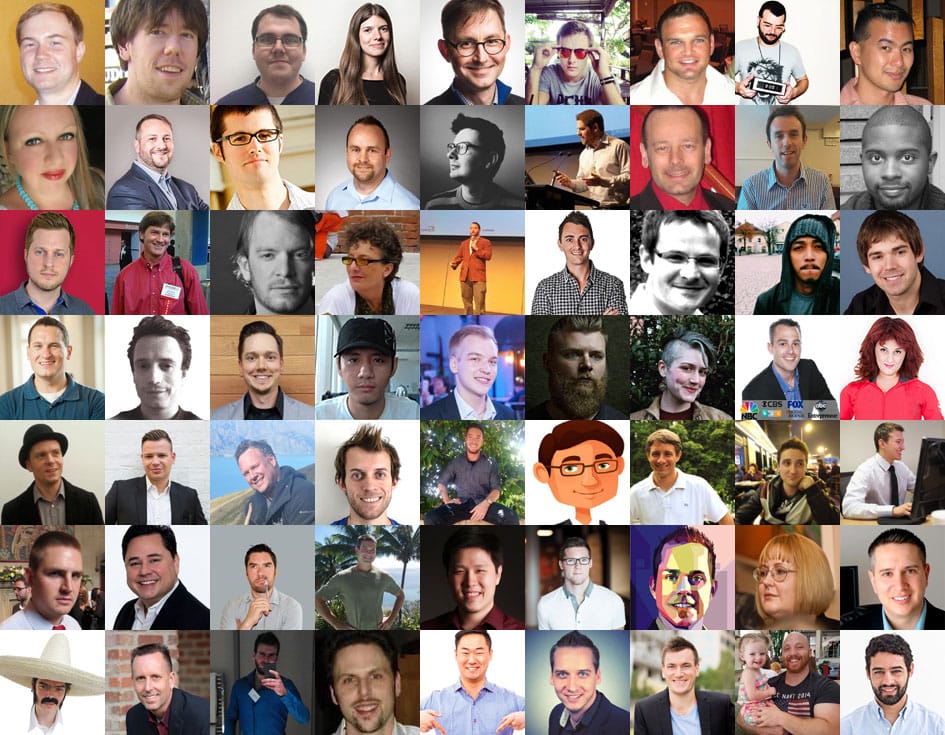
Looking for the best ways to improve your SEO?
Yes, it can feel overwhelming when you have to sort through the mountains of SEO techniques out there…
So, before you use a technique, you want to know that all the time and effort you spend on it will be worth it in the end.
We decided to find out which techniques are the most important to focus on, so we reached out to 62 experts and asked them this question:
What is your #1 Actionable SEO Technique?
Their responses cover a vast range of techniques, such as writing quality content, on-page SEO optimization, influencer marketing, guest blogging, networking, analyzing competition, outreach to bloggers, and optimizing for keywords you are already ranking for, as well as optimizing for searcher intent, for user experience, for semantically related terms, for CTR from search engines, for location, and much more.
We’ve list all the responses below:
Write Quality Content
When it comes to SEO and creating content that will rank at the top of the search results, I like to make sure I have all of my angles covered.
The first thing I will do is find a topic or search phrase that I want to rank for. Then I analyze the competition and quality of the sites that are currently ranking.
Next, I will focus on my content and make sure that I can do at least a 1,000+ word resource guide that provides real value. If applicable, I’ll also include original images or videos and even create an infographic based on this content.
With all of this in place, it will make it much easier and more effective when trying to build backlinks and references back to the site. You can see a working example of this in my make money blogging guide.

Zac Johnson
Use Influencer Marketing
Take an influencer out to lunch. Find a blogger who has an existing audience in your niche, shoot them an email, and find a nice restaurant to take them to.
Build a relationship with them, and leverage this relationship to get content published on their blog and pushed out on their email list and social media channels.
You’ll get some good links and exposure, which will open up doors for other links and more exposure, and Google will take notice.

Eric Hebert
Interview Influencers
When it comes to search engine optimization (SEO) techniques, everyone seems to have an opinion. The trouble is, many techniques serve the search engines and not your audience and readers.
But there is a way to do both: do audio interviews of influencers and experts on your topic. Yes, it can be a podcast, but it can do so much more for you than get you listed in “New and Noteworthy” in iTunes.
Text transcripts of interviews you do with leaders in your topic focus are a terrific way to get keyword-rich content on your site. Most bloggers have a difficult time creating long-form blog posts that have the right percentage of keywords that will be indexed highly by Google. The beauty of a transcript of an audio conversation is that it will naturally have a lot of the keywords you want to rank for, and you don’t have to manually insert them into blog posts in a way that might seem forced.
You can find people to transcribe your audio on Fiverr (make sure they are native speakers of the language your audio is in) or a service like CastingWords.com. Then use a service like SoundCloud.com to embed the audio and post the full transcript below.
The transcript is what works, so you can even consider not posting the audio at all and using just the transcript.
I have used transcripts to create keyword-rich blog posts for many years. It’s a fast way to get a site ranked higher in Google – naturally!

Tim Bourquin
Optimize for Google Questions
A lot of people type questions into their search engine. How can you be optimized for those questions? Ask the questions, then provide the answers. That’s right: a mini-FAQ at the bottom of each page.
If the website is for a pet store, gather the types of questions customers ask, and sort them by page. For instance, if you have a page for goldfish, assign those questions to the goldfish page. Ask the question, then answer it. For instance:
Q: What do goldfish eat?
A: Goldfish eat pet food.
OK, so you’ll need a better answer than that. But you will not only optimize your page for specific question searches, but also add content that will make the page more attractive for a plethora of long-tail queries.

David Leonhardt
Do On-Site Optimization
The most actionable thing you can do for SEO is all on-site optimization. This is the entire half of the equation which is directly in your control, and it’s foolish to start anywhere else.
Do the keyword research to see how your prospects are searching, look in your analytics to see how much organic traffic is going to which pages, use your rank tracking tool and the Google Search Console to see what pages are visible for what, and map out all the keywords over your content to make sure you’re not competing with yourself or missing major gaps.
Look for low-hanging technical fruit on your site like indexation, canonical, crawling and mobile issues, design a proper internal linking structure, and make sure your information architecture makes sense.
Check Google’s index to see how much and which pages are in there, and make sure your content is better than the competition. Everything on your site is actionable because it is under your control!
Way too often I see people diving immediately into link building and off-site promotions, but that’s just putting the cart before the horse.

Harris Schachter
Use SEO Spider’s Web Strategy
Unfortunately I’m about to disappoint you… Because there’s no magic pill, formula or trick when it comes to effective SEO.
There are lots of factors that the big search engines consider when ranking your content. The good news is you don’t need to focus on all of them.
Instead you should focus on the real game changers, with the biggest influence on search ranking:
- inbound links from authoritative sites
- content and lots of it – packed full of helpful information and a consistent proportion of keywords
- user experience including site architecture, internal linking and bounce rate
These are the SEO game changers, and they are all influenced by a strategy I call The SEO Spider’s Web.
The SEO Spider’s Web is the architecture that will guide your content strategy, fill your editorial calendar and boost your search rankings.
If you’re just starting a blog – this process will lay the foundation. Or if you already have a lot of content, this will guide your content strategy moving forward and accelerate your way to better results.
The basic idea of this concept starts with content anchors; these are the cornerstones of your strategy. These anchors are long pieces of highly useful content that dominate a specific topic, and are optimized for a broad keyword term. Once you have a set of content anchors, you tailor the rest of your content strategy accordingly. Blog post topics and their associated keywords stem from these anchor topics, and link back into them internally.
And your sole purpose for building external links is to boost the rankings of these content anchor pages – giving some purpose to your outreach efforts. Over time you build a strategically architectured spider’s web of internal and external links that support themselves using these anchor points.
Read more about this SEO strategy here.

Will Blunt
Analyze Competitor Links
Monitoring your competitor links is the one of the most crucial parts in SEO. We know that links still contribute huge value for better ranking and exposure.
To do this, there are some methods you can add to your daily SEO activities that you do for your clients/websites:
- Monitor your competitor links. Monitorbacklinks can give you a list of URLs your competitor gets on a weekly basis. There are other tools you can use, but to give you automatic reporting, this is probably the best fit for you.
- Track their brand for mentions. Tracking your competitor brand name or identity online can give you an advantage to know what they are digging into.
- Replicate their newly built links. When you have a list of your competitor’s links, you can give yourself a try getting a link from the same domain your competitor got a link from.
The key here is not to monitor only your high-ranking competitor. Low-ranking competitors may be working their way up to the top, so you have to make sure they are monitored.

Joseph Gojo Cruz
Optimize CTR from Google Search Results
The most actionable SEO technique that I know of is to re-optimize your low click-through rate but high- potential content that Google already deems worthy to rank.
To identify this subset of content, go to Google Search Console and open the Search Analytics report. Select “Pages”, click the check mark to show “CTR” (click-through rate) and set the date range as long as it will go. This will give you a list of the URLs on your domain and their associated CTR in Google SERPs. Next, click a URL with high clicks but a low CTR (lower than 5%).
After doing that, click “Queries” (doing this will still have the Pages setting filtered by the URL you clicked in the last step). You now have the CTR of the queries that are leading to the given URL.
Identify a query that has a low CTR but high potential (meaning it could lead to a conversion given the context of your URL) and do the standard best practice on-page optimization (title tags, alt text, keywords in content) on that page for the query you have identified in the aforementioned report.
The beauty of this method is that it relies on data that shows which URLs Google is already deeming worthy of ranking well and then helps those pages rank well by optimizing them for worthy queries.

Danny Dover
Do Topical Analysis for Key Pages
Whether it’s RankBrain, Hummingbird, or some other part of the algorithm, it’s clear that in the past year or so Google has ratcheted up its ability to analyze the thoroughness with which a given page covers its topic. I’m in the camp that believes Google is doing this by measuring co-occurrence of related terms: looking at the top X number of pages for a term, seeing which relatively rare (e.g. NOT “and”, “but”, “the” etc.) terms crop up on a good number of those pages, then scoring each page on how many of those terms it has.
I’m a fan of using Ultimate Keyword Hunter to do the work for me, telling me what those terms are, and how many of the top pages in Google for our search term have each of those related terms. You then go through the list of terms that show up on more than just 1 or 2 of the pages, and if you haven’t mentioned that term (and it makes sense to), incorporating it into the content of your page.
It’s important to recognize that even if Google isn’t doing this type of mathematical analysis to determine relevance and thoroughness of your page, by doing this, you’re going to spot real subtopics that you hadn’t thought of covering, as well as synonyms for terms you did cover and might use as an alternate term somewhere in your page content.

Michael Cottam
Build Awareness in Other Channels
Try to build awareness in channels other than search to help boost the efficacy of any other SEO-related investments you engage in. This can consist of just about any form of marketing, including:
- online or offline networking
- social media ads
- remarketing
- email marketing
- getting coverage on popular sites in your market.

Aaron Wall
Optimize for Keywords You Are Already Ranking for
SEO is slow. But there is one way to increase Google rankings quickly. The trick is to find the phrases that you’re already ranking for, but not ranking that high. You can do this using the Search Console > Queries report in Google Analytics. Add a filter so you look at just the phrases for which you rank high on page 2:
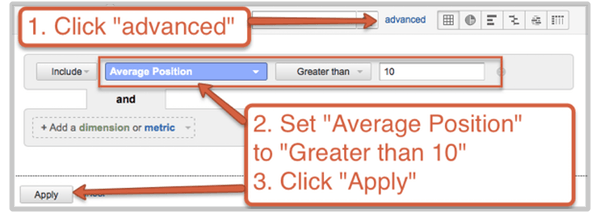
Next, scroll through this list. See any surprises? Pick out some phrases and search for them. This will help you both confirm the ranking and find the corresponding page. Finally, once you’ve found the page, take a close look at it with an eye toward relevance and quality. Ask yourself these questions.
- Did I use the target phrase in the title, header and body text?
- Is this page likely to meet the expectations of a visitor who searched for the phrase?
- Can I make this a better page by covering the topic more thoroughly?
- Is this the best page on the internet for the topic?
Make the changes by indicating relevance, by improving quality, then come back in a week and check the rank again. It probably jumped from the top of page 2, to somewhere on page 1…
You can see the full, step-by-step instructions and a video describing this tactic here: How to improve your Google rankings in 9 steps. Happy rankings!

Andy Crestodina
Find Websites’ Hero Terms & Steal Them
While I was working with a travel client, they asked me to create a blog schedule for the year. Using tools such as SEMRush and SearchMetrics, I researched around 150 travel blogs to find out which of their key terms brought in the majority of their traffic.
What you will find is that blogs will get around 60-80% of their traffic from just a couple of pages, where they have gained high rankings for a high search volume term.
Nicknamed “low-hanging fruit” or a blog’s “hero terms”, as long as they relate to your business, you simply need to assess how many links these posts have, how many social shares, the word count and any rich media used to get an idea of the amount of effort it would take to get a top 3 ranking for these key phrases.
The travel client increased their blog traffic by 80% within 6 months due to a number of these pages gaining strong rankings for the terms I researched.

Tom Bourlet
Pick. Up. The. Phone.
I was working on a blog post for myself called “How to build links with your smart phone” and was trying to access my favorite SEO tools, and it was horrible. I tried loading and looking at Analytics on my phone’s Chrome browser and it was horrible.
I tried the Analytics App and it was impossible to dig into the info I wanted and impossible to easily export it. I tried reviewing the client’s sites and coming up with ideas when I took a call from one of the outreach targets I’d sent an email to asking some questions and getting really excited about the guest content I’d offered.
That’s when it hit me: the smartest way was to use my Android as a phone, not a mobile computer. I now leave an email for myself with potential outreach phone numbers to try when I’m stuck, bored, at the thrift store while my wife is shopping.

Jeremy Rivera
Build Hyperlocal Links, and Link from Blog Pages to Internal Pages
For larger websites, one of the most rewarding actionable SEO techniques is setting up proper cross-linking and links from the blog pages to internal pages. Works like a charm every time.
For local clients with smaller websites, one of the most rewarding actionable SEO techniques is to build links from hyperlocal resources. I see most people still building citations and/or links from very general resources, but most authority for local SEO comes from local websites (libraries, local businesses, local schools etc.). Finding ways to sponsor events, give discounts, run promotions or create useful resources on the client’s website that would drive links from local websites will drive better results than building links from large general websites.

Vlad Rascanu
Optimize for Keywords You Are Already Ranking for
If your website is already ranking for a number of keywords, use this technique to score quick ranking wins.
Log into your website’s Google Search Console’s Search Analytics page (the one that shows which search queries your site is ranking for) and check on the “Position” option – which should populate an “average ranking” number next to each search query. This represents the ranking position that your website appeared in for a particular keyword.
Next, find the keywords that are ranking in position 11-30 that get clicks and/or impressions. These queries aren’t ranking on the 1st page yet they still receive traffic – bumping them to page 1 rankings will provide significantly more traffic.
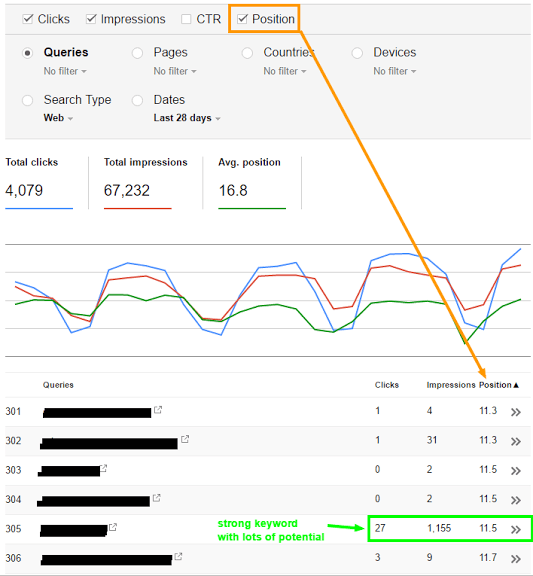
Once you’ve determined a query, see which page is ranking for it. First select the query, then select “Pages” to view a list of pages that rank for that query.
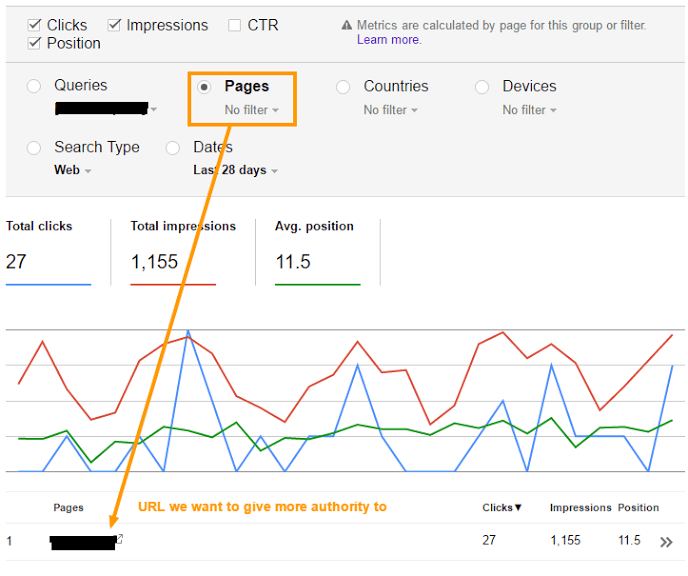
Choose the most relevant/best ranking page and:
1) Link back to that page from other pages on the site with the keyword query as the anchor text
2) Optimize the page a bit more to rank for that specific query (e.g. add the query within the content again)
These small tweaks should bump your pages rankings and significantly improve its organic impressions and clicks.

Oleg Korneitchouk
Optimize for CTR from Search Engines
Regularly use your Search Analytics data in Google Search Console to consistently revise and update your content.
Google Search Console (unlike its Webmaster Tools predecessor) provides a wealth of useful SEO data directly from Google (and only available to you, not competitors). The most useful report is Search Analytics. For revising your content, I recommend sorting the data by page, and then clicking on your top pages to view the queries generating impressions for each page.
Look for keyword variants and phrases that are generating impressions but few clicks. Revise and update your content to address those variants and phrases. It’s not a magic bullet technique, but it will generate consistent gains that add up to big wins over time.

Nate Shivar
Earn Relevant Links
SEO falls into two loose halves: relevance and authority. Relevance is having the content that answers a given question. That could be as simple as stating that you provide a given service in a given location. Or you can go down the rabbit hole of content marketing.
Authority primarily relates to how a search engine orders the results.
Then, if there are several results – all of equal quality – how does the search engine stack the deck?
There are a lot of moving parts here but the really big one is links, and any serious search engine optimization campaign will require link building to succeed.
So, any strategy that is actually going to work – and many SEO strategies don’t deliver results – must consider these core components: content and links.
The caveat here is they have to be the right links. They have to be links from sites, people and organisations that Google believes to be relevant and authoritative. They have to be links from sites that Google trusts. So as an SEO you have to identify these highly relevant and trusted sites and determine how to get a link.
But how do you do this? How do you know which sites Google trusts? There is no end to the SEO tools available for you to use, but the answer is right in front of you and totally free: use Google itself.
Google only returns sites that it trusts. And of course it orders them by relevance and authority. That makes it the perfect tool for identifying link prospects.
There is no end to the ways to do this, but three of my favourites would be:
- Search around the subject
You know your keywords, so have a search around them. You may need to use a bit of common sense here, but if you’re a marketing company in the UK then search for marketing, marketing magazines, marketing blogs. Find the sites that rank highly around your topics and determine what you need to do to get a link from those sites.
- Content submission
There are many sites that allow you to submit an article or content. So, again, use your keyword or keywords along with a couple of other phrases that would indicate that the sites returned are highly relevant. The following are a few examples. Simply replace “keyword” with your word or phrase of choice and review the link opportunities.
- Keyword submit content
- Keyword submit article
- Keyword submit post
- Keyword submit blog post
- Keyword add article
- Keyword add blog post
- Keyword add content
- Guest blogging
Guest blogging is another way to get links from these sites.
- Keyword guest blogger
- Keyword “guest blogger”
- Keyword guest writer
- Keyword guest blog
- Keyword guest post
- Keyword “write for us” OR “write for me”
- Keyword “submit a blog post”
- Keyword “guest post”
- Keyword “contribute”
- Keyword “contributor”
Bonus strategy
Most guest posts will allow you to link back to your site in the bio. This is great but a link to a specific piece of content on your site, maybe with some of the terms that you wish to rank for, can be even more useful. To supercharge this strategy you can create a best-of-class piece of content and host it on your site.
These posts then talk about a small section of that piece, and link to the main piece in the body of the post. You also get a bio link. So you get two links for the price of one. Add to this by simply identifying and letting people know who have linked to similar (but not so good) content and you can scale those links.
As ever, the best links will require some input and this approach is no different but this approach is super actionable. You can identify all your ideal link targets in an afternoon and then set to work earning those links.

Marcus Miller
Optimize for Keywords at Page Level
My #1 actionable SEO technique requires about a day and is at the page level. If we have a good sense for what the most important keyword is for a page, we’ll pull keyword and link data from the top 20 ranking pages for that search term via SEMRush (keywords) and Ahrefs (links), creating a pivot table sorted by frequency.
Using those insights, we’ll plan native advertising and content marketing opportunities, and re-calibrate keyword targets based on existing conversion data first and competitor insights second. When done, we’ll compare our page side by side to the 20 top-ranking pages, looking at cross-device and cross-browser compatibility, mobile-friendliness, PageSpeed, structured markup, media (images, videos) and simple but strong conversion focal points. We’ll monitor rankings and continue to adjust based on results.

Steve Wiideman
Ensure Your Content is Freakin’ Awesome
Start a content strategy and ensure that your content is totally freakin’ awesome – better than anyone else’s on the subject matter. It’ll naturally attract more inbound links and shares that way, which will strengthen your entire website’s search visibility.
For help, see my guide on planning and launching a content marketing strategy.

Jayson DeMers
Network for SEO
My #1 actionable SEO technique is to focus on networking. I know that isn’t directly SEO, but so many SEO related things come as a result of good networking. You get links to your content, you get opportunities to guest post for others, you get podcast invites, and all of these things lead to more people linking to you and inviting you to do more interviews.
The fact I’m doing this round-up post in 2016 is a result of networking I did in 2014, which raised my profile and brings a constant stream of links and opportunities to my door.

Dominic Wells
Write 10X Content
If I were to choose 1 technique out of all the possible arsenals when it comes to SEO, it’s this: write 10x content. It’s a piece of your brain that is put in a webpage. It may include a video, an infographic, lots of images and, yes, definitely lots of words about the topic of the keyword/phrase you want to rank for.
Publish that and promote it like hell. One hack to promoting is Quuu – it will set you back some dollars, but it’s well worth it.

Sean Si
Check & Fix Not Indexed Pages
The single most important metric to consider when optimizing pages for SEO is index status. It’s simple, really – if your pages aren’t indexed, there is no way they will rank for anything.
It is easy to overlook indexation in this day and age, since Google has got so good at finding, crawling and indexing URLs. However, that doesn’t mean they are necessarily doing it correctly for your site, and it is always worth checking.
With small- to medium-sized websites, you can handle this without any paid tools if you make the most of Google’s free offerings. By using an optimized sitemap index, you can get granular detail on the indexation rate of each sitemap – all through Google Search Console (which is free, obviously), in the Sitemaps report. You can also use visits tracked by Google Analytics as a proxy for indexation. If you find a page you’ve had visits from from a Google search over a given time period, it is a safe bet that this page is indexed (otherwise, where would the traffic have come from?).
If you’ve done these steps and still need help, you will probably need to use a paid tool like URL Profiler, which has a specific indexation checker feature (here is a specific guide on auditing your sitemap to find indexation gaps).

Patrick Hathaway
Optimize for Google’s Direct Answer Box, and Optimize for Local
We’ve definitely moved into a more interesting time for search – not only in terms of how to get in front of the searcher, but also the level of technology to search on. Look at the variety of mobile devices we now have, up to and including Google Glasses and smart watches. We used to tell people that they might want to start looking at making sure they have a mobile website. Now we’re telling them, “Make it responsive or go home and quit.”
Local: Global is all well and good, but local is where the real action is at. People usually look to find if an international company has a local office. If you’re an international company, you need to have your locations separated out, and be clear as to where they are. No more, “Oh yeah, and we’re also in…” Local citations are strong signals, and they’re important for local rank as well as mobile rank.
Structured data & direct answers: Aim for Google’s direct answer box and rich snippets. If you can mark up your site with schema, microformats or other markup, do!

Gabriella Sannino
Get the Right Tools – Ahrefs & SEMRush
My #1 SEO tip is to get yourself proper tools, like Ahrefs and SEMRush. After that, the possibilities are endless. See exactly what your competitors are ranking for, that you’re not ranking for. Create killer content for those keywords and then look at every backlink they’ve got to those pages and replicate them, plus build more!
It’s a pretty foolproof system once you’ve got access to the data on what your competitors have done.

Karl Kangur
Use Broken Link Building Strategy
My #1 actionable SEO technique is broken link building. If you are not familiar with broken link building, it is a process in which you identify websites that link to URLs that are no longer working.
Once you have found a site with a broken link, you reach out to them and let them know it’s not working. At the same time, you can offer up your working link as a replacement. You are letting them know of the issue and providing a solution to the problem.
While it is a tedious process, it typically provides better SEO value compared to simply creating new links on new pages.

Chris Makara
Analyze Your Competition
I use tools like SEMRush to get a quick overview of my sites’ performance and to better understand what my competitors are doing. Using the competitor tool, I can enter my site and compare it to another, for example Charli Says versus Social Media Examiner.

By identifying articles which produced better results for competitors, I can analyse keywords, backlinks, rankings and hot topics.
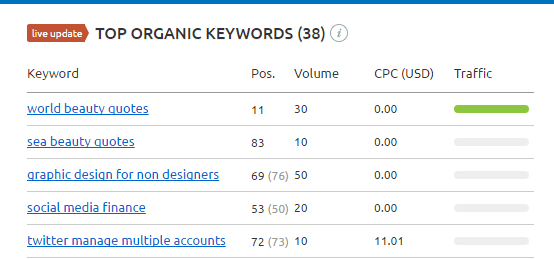
I also look at the shares of such articles, because this plays a big role in the overall SEO wellbeing of your site. Of course you know your content has to be original, but by knowing the SEO structures of competitors you will have a better chance of eventually outranking them on SERPs.

Charli Day
Build Relationships
My #1 SEO technique is a bit unorthodox, but it comes down to building real relationships with other bloggers and experts within your field – not the type of relationship where you’re mass messaging hundreds or thousands of people looking to get a guest post published (although when done well guest posting can be effective), but rather true relationship building.
A lot of the friendships I’ve made and the relationships I’ve developed have evolved into help on the SEO standpoint. For example, I had a company mention a link to my blog in a post they wrote which was picked up by a handful of larger media outlets – so I got some great links without even writing the content.
That only came about by trying to develop real solid relationships with others within my industry. Although it’s not a technical tip, it’s a big picture strategy that I think gets lost.

Chris Guthrie
Build Links with Information Pages and Redirect
Build links with informational pages. After a while, redirect informational pages to related commercial pages. Do all of this while reposting the informational content on a new (non-redirected) URL.

Jordan Kasteler
Analyze Competition, Outreach and Guest Blog
- The first step in preparing an SEO campaign is to analyze competitors. Use a backlink tool to figure out what your most successful competitors are doing to get links to their websites. Some popular tools include Ahrefs, SEMRush and Monitor Backlinks. A successful SEO approach can vary greatly, depending on what niche you are in and what you are trying to rank for.
- Email outreach can be effective for content marketing, especially if content attracts a lot of links in your niche.
- Get publicity and create awareness for your brand, as some people will link to your website naturally if they know about you. Guest blogging is one of the most popular ways to achieve this for content marketers, but PR, social media and influencer collaborations are just a few other methods that can help.

Brian Lang
Do On-Page SEO Optimization
Spending significant time on on-page SEO to optimize your page intelligently is my favorite actionable SEO technique. Irony alert: until recently, I’d never paid much attention to SEO. But seeing as following a few basic steps helped me land on page 1 of Google for semi-competitive keywords opened my eyes. Big time.
Write clear and actionable meta descriptions centered around your keyword. Use said keyword in the opening paragraph of your blog post. Don’t forget to use the keyword within one set of H2 tags.
Write a pillar style, long-form post of at least 2,000 words or more, rich with outbound links to reputable sites, to get your SEO game down pat. Readers expect resources on page 1 of Google, so Google gives precedence to thorough, helpful articles linking to relevant, quality posts on your blog as well as linking out to resources.
Think practical tips. Write something that lays out, step by step or tip by tip, how to do something practically in your niche of choice.
Drive traffic through social media sites like Twitter, Facebook, G Plus and LinkedIn by maintaining an active presence on each network. Promote other bloggers freely and they’ll promote you. Good SEO these days is not about gaming a system; it’s about establishing connections, helping other bloggers by promoting them and generously sharing value through your blog.
Consider crafting a numbers-based title, as number-themed titles seem to rank well on page 1 of Google for a variety of keywords.
I held down the #2 spot on page 1 of Google for “marketing your blog the right way” from a few hours after I published a recent post – until today, 4 days after the post went live. Here it is: 7 Practical Tips for Marketing Your Blog the Right Way.
Studying the post can clue you into my strategy for writing a post to land on page 1 of The Big G.

Ryan Biddulph
Focus on Long-tail Keywords to Attract More Traffic
My #1 SEO tactic is to focus on creating content about long-tail keywords. Most people focus on long-tail keywords just because they want to rank for a bunch of them and get the extra traffic. However, the reason I recommend creating content based on long-tail keywords is that once they’re ranked they attract a lot of backlinks.
A lot of the time, people doing long-tail searches fall under one of these two categories:
- bloggers writing an article who need a source for a specific point they’re mentioning
- people looking for a solution to a problem.
I’ll go over both of these really quickly.
For the first one, let’s say someone is writing an article about being left-handed. The keyword “left-handed” gets a high search volume, but it’s super broad. But within that article they’re going to reference a lot of keywords that are more in-depth and specific, like “percentage of left-handers”. They’re going to need to research that phrase to find the information and a source to include. If your article about how many people in America are left-handed is ranking on the first page of Google, they’re likely to link to you as long as your content is accurate.
The second group of people are looking for a solution to a problem. A prime example of this is an article I wrote about how to downgrade WordPress. This is a very specific problem that a lot of people have, and it has a ton of different long tail searches around it. By ranking on the first page of Google for these different long-tail phrases, people see my article as a good resource. So they share it on their blogs and on forums, which earns my site some nice organic backlinks.

The beauty of this tactic is that, with good keyword research, you can find long-tail keywords that you can rank for without any backlinks. But then those articles turn around and generate a ton of backlinks for your site! I use Long Tail Pro to find these types of keywords and then create a high-quality piece of content about it.

Dominique Jackson
Reach Out to Get Google Reviews
Get more reviews! An often neglected but important aspect of local SEO is Google reviews – and you don’t have to do very much to get them. Reach out to existing happy clients and ask for one – it’s really that simple. What works even better is having a process around asking for Google reviews – you will certainly see significant benefits.

James Richardson
Optimize for Semantically Related Terms
SEO can get a bit complicated, particularly if you want to improve your technical or off-page SEO elements. For those items, most businesses find it’s best to simply outsource to white-hat SEO firms.
On-page SEO, however, remains fully in control of the site owner or webmaster. But on-page SEO has evolved. It’s no longer about stuffing keywords into the page title and body copy, plus the alt-text and other areas. If it’s not about all that, then how do we pursue keywords, you might ask? Simple answer: you target semantic match.
Semantic SEO is a major piece of the puzzle these days. Google has already stated that it no longer ranks keywords. Now it ranks topics for intent. That’s right, Google is guessing what you really need to see and trying to serve that up.
How do you target semantic SEO? By using a combination of head terms (what we used to call keywords), long-tail versions of those head terms (what I call derivative keywords, since one keyword is “inside of” another) and semantic terms – that is, synonyms or closely matched terms that use different verbiage.
Put all of these keyword types together, use a range of them to optimize the on-page elements, and see how your SEO improves. Use a long-tail version of the head term in the page title and H1. Put in various derivatives in the alt-text and subheads. Then add the semantic match terms or synonyms all over in the body copy. Where we used to create unreadable blocks of content with a keyword repeated a dozen or a hundred times, we can now use a range of similarly defined words to make it sound like… gasp!… real English!
You may be surprised at how easy it is to tell Google what a page is about if you adopt this approach. We have been doing this at Return On Now for over half a decade. When Google Hummingbird hit, we didn’t flinch. RankBrain? No problem. Both of those major updates aligned with this perfectly. So try it on your own site. You’ll be glad you did.

Tommy Landry
Analyze Your Competition and do it Better
Determine what your competitors are doing to rank their websites and do it better.
- Find out how many indexed pages they have by doing a “site:[inserturl.com]” search & create more high-quality content than the competition.
- Do a local and national level backlink analysis using OSE, Magestic, Ahrefs and SEMRush to determine which backlinks are ideal candidates for link acquisition in the most competitive geographic locations.
- Analyze which content is driving organic traffic with SEMRush & Ahrefs to their website and create a better article and landing page that is more helpful to the consumer.
Remember, your competition may be doing the same thing to you. So make it difficult for them. I like to create barriers to entry for my competition. By that I mean that I create assets that aren’t as easy to replicate. Barriers could be exceptional content, scholarship campaigns, charities, video, audio, podcasts, influencer outreach etc. A barrier is something that provides substantial value to your digital SEO presence but is more difficult to replicate than generalized age-old tactics like directory submissions, paid editorial reviews, social media etc.

Chris Dreyer
Write More In-Depth Evergreen Content
When you’re writing a piece of content, it’s easy to cover a subject by banging out 500 or 600 words on a subject and hitting the publish button. Although you might feel you’re covering a subject thoroughly with such a short blog post, Google feels otherwise.
The average Google first page result contains almost 2,000 words. For the typical writer who writes 700 words an hour, this means you can expect to spend almost 3 hours on a single blog post. That’s right, buttercup, that’s a long time. Now, if you’re covering things like breaking news, it’s not worth spending so much time on an article. That’s why you really need to focus your efforts on “Evergreen” content – content that’s always relevant and stays “fresh” for people for a long time.
Take your time and produce ageless, in-depth content that solves your target audience’s problem.

Rick Ramos
SEO Optimize Your Content
Use your keyword in the title of your post, and the keyword again in the first paragraph. This is the simplest, easiest to understand method of ranking for low competition keywords. Of course, in this very bare form, it works best for long tail keywords of at least 4 words long. 5+ words are best!
You are welcome to use more keywords in more places (without stuffing) in places like H3 or H4 tags, but many times those aren’t necessary. There are also more complicated ideas like using LSI keywords in the article, but, in terms of effectiveness, simple is best! Things like outreach, links and other kinds of off-page SEO can be effective as well, but they’re certainly harder to do, especially for newbies. Cracking the code of how to get mentioned and linked to by the big players in your industry is really tough for newbies.
That’s why I like the idea of focusing on on-page SEO. It means a new internet marketer can work on optimizing their own site, and getting their own content on point, which will help them in the long term. It also means they can save money and time without needing to work on building or using a PBN, which I highly recommend against!

Nathaniell Brenes
Focus on Technical, Content, and Off-Site Publicity
My #1 actionable SEO technique is actually harder to explain than just to say “do link building” or “write blog posts” – it completely depends on where you’re at with your website and your business.
Do you have a very antiquated site that technically has a lot of struggles? If so, I would recommend upgrading to a more modern framework that is suited to the current environment we live in. Making sure your site is responsive is a way to future proof it for the most part, and make sure that you’re getting the mobile-heavy traffic that you should.
Does your site lack a good amount of content talking about the products or services that you provide in many different contexts with many different keywords being targeted?
In that case, figure out the best types of content and styles within your industry that are reacted to well, write content or create videos, slideshows, or other types of content that can both promote those products or services while also providing their own unique value to your customers and newcomers alike and place those on your site.
Does your site lack a lot of outside exposure?
Are you writing a lot of content that isn’t getting a lot of views?
Perhaps you should look into which publications are writing about your products or services within your industry, then focus on building relationships with those publications so that you can contribute content and acquire a bit of their audience share for your site.
It completely depends on where you’re at, but those are the 3 main areas I’d focus: technical, content and off-site publicity.

Sean Smith
Make Your Website Fast Like a Cheetah
Every SEO professional knows that page speed is important. A faster page means a better user experience and higher Google rankings. In fact, site speed is one of the most important SEO factors in 2023. Internet users don’t like slow-loading pages, and neither does Google, especially on mobile devices. Page speed has been one of the signals used by Google to rank pages since 2010. Make no mistake: a slower page leads to a higher bounce rate, lower conversions and a less favorable page rankings.
What to do to increase your site speed pronto? Compressing images with a good optimization tool such as Kraken.io is a good place to start. Large images slow down your landing page’s loading time tremendously.
Another good practice to keep is to clean up your plugins and code – if you’re not using something on your site, get rid of it. This could be old spammy comments, deactivated themes, old files on your server and unused plugins and widgets. Deactivate and delete mercilessly. Chances are, there’s something on your site adding unnecessary requests and slowing you down.
Another good tactic to consider would be setting your page to leverage cache. When you set your page to cache, information is saved, and browsers don’t have to reload the entire page every time a visitor comes to your site. If you’re using WordPress, this could be done through the use of a plugin such as W3 Total Cache, or WP Super Cache. Google has some guidelines available for page caching as well. Lastly, make sure you enable AMP (Accelerated Mobile Pages).

Matthew Capala
Use Entity Salience
The best kinds of SEO techniques are the ones you can implement into your content immediately. That’s why my #1 actionable SEO strategy is an advanced on-page technique called entity salience.
It may sound complicated, but it’s really not. It’s a concept that Google and other search engines like Bing are pursuing as means of finding relevant content.
To start using entity salience today, follow these steps:
Establish strong “entities” in your content by using specific and detailed long-tail keywords.
Draw connections between these entities to strengthen the page’s relevance. (For example, if you’re writing about Game of Thrones, mention Ned Stark, Jon Snow and The Mother of Dragons, and give all these subjects depth and detail.)
Go as deep and as detailed as possible to not only showcase strong entity connections but also provide a detailed and high-quality piece of content.
This is a great on-page SEO technique that you can implement today for any type of site: blogging sites, ecommerce stores, saas sites and more.

Matt Banner
Find Less Competitive Titles for Posts
Before you write a new post, column, or article, take a moment to see how many other sites have already written articles with the same title you were planning to use. You can do this by enclosing the title you were planning to use in quote marks, and searching for it on Google.
Let’s say you are writing for a veterinary site. You want to write a post about picking the appropriate pet for a small house. I tried several different title searches and kept finding already existing content. There was a lot of competition. Then I tried this one:
“How to pick the best pet for a small house”.
I was surprised to see that Google showed nobody had ever written a post with that exact title. Take a look.
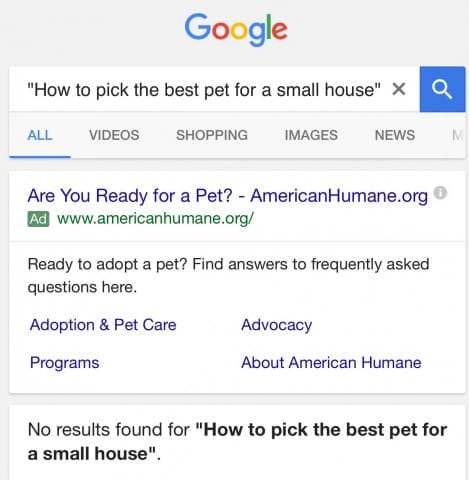
While this technique won’t guarantee your content will rank 1st, the point is that even if your article is fantastic, if there are already many articles with that exact title, especially from well known “brand” content sites, yours is not likely to be found. So why fight a losing battle? This process only takes a few minutes. A few subtle changes to your post title could make a big difference.

Eric Ward
Write the Best Answer to a Question People Have
My #1 most actionable SEO technique is to write the best answer to a question people need to have answered. Say you sell training programs – Google training programs to see the results. The results are all outdated, irrelevant and a weak representation of your industry. Provide a better answer, be genuinely useful, and you’ll beat the pants off the competition.
Use this success as a way of finding momentum. Where else can you provide the best answer? Which segments of your target market are under-represented? Investigate, discover, improve, repeat.

Jeff Sauer
Optimize for Searcher Intent & User Experience
User experience is a big thing for Google, and it’s only going to be more important as time goes on.
Why?
Think about it. If Google just delivered search results to its users with poor user experience, how long would it be before more people started using Bing or DuckDuckGo?
Probably not long.
My advice is this: focus your efforts on optimizing for searcher intent and user experience.
- Think about the search queries that people would use to find your content, and exactly what they need to get out of your content.
- Then craft your content with user experience in mind. Here are a few of the basics to consider:
- Ensure your site is mobile responsive (it should be by now…).
- Make your content easier to digest and to take action on. I read so many posts that list a bunch of things I should do, but then don’t tell me how to do it or give me any references to go by. That’s the kind of feeling you want to ensure your readers don’t have.
- Improve readability. Break up large paragraphs, use relevant images, use bullet points and other formatting elements. Also, typography comes into play here. Less is more.
- Make your content easier to navigate. If you’re writing long-form content, adding a contents section at the top with “back to top” links can be helpful.
This is just a small list that covers some of the basics. There’s a lot more that can be done, but this will get you started.

Adam Connell
Optimize Your Content for Keywords You Are Ranking for
My biggest SEO tip, and one which I find can give you the most bang for your buck, is optimising for keywords you’re not specifically targeting.
You can do this via a number of different data sources, most notably Google Search Console or SEMRush. Every month check to find keywords for which you’re ranking in the 11 to 30 range, that you might not have targeted for a page. These will often be synonyms or other variants that Google feels are relevant to the content on the page.
Prioritise these pages based on the commercial value of the page and the volume of the traffic you could potentially reach. Then it can be as simple as tweaking a few on-page elements, adding some more images or writing 200 or so words of additional content for the page.

Jamie Spencer
Listen & Observe to Validate Searcher’s Mental Models
My #1 actionable SEO technique is probably going to sound very odd to many search marketers, because I truly understand the value of many common SEO techniques: broken link building, writing unique titles and headings, expert roundups, influencer outreach, re-purposing “old” content and so forth.
I also value software that makes an SEO’s job easier (link building and analysis, site architecture, site speed etc.) The tools available to SEO practitioners and link builders is far better now than when I started out as an SEO over 20 years ago.
My actionable technique has very little to do with technology. It’s simply to listen and observe actual users interacting with your website. All of these SEO and link-building tools are less effective if you don’t understand user mental models. I gain more insight to user goals, pain points, roadblocks and even keywords when I listen and observe.
Then I use my favorite tools that are applicable to my SEO project.
And then I listen and observe again… and again… and again. It’s an iterative process. I want to validate user/searcher mental models and help them achieve their goals.
Tools are only as effective as the person using them. Make the time to be a better listener and observer.

Shari Thurow
Focus on Conversion Rate Optimization for SEO
My top actionable SEO technique actually isn’t one. SEO means nothing if you don’t also understand conversion optimization.
If you want to make more money from your SEO efforts, focus on optimizing for users first, search engines second.
You could send all the traffic in the world to your website via SEO (or paid search), but if your website isn’t set up to capture visitor information or convert visitors into paying customers, what good is it?
Whether you’re writing affiliate blog posts, trying to get new clients for your service-based business or selling via e-commerce, focus on the specific goals you want your visitors to meet once they land on your website.
Ask yourself if your pages answer the questions people have before they will take the next step and buy. Do your pages have strong calls to action and create a sense of urgency? And, most importantly, does your website feel trustworthy?
By optimizing some of my top performing posts for better conversions through the Content Upcycle Method, I generated more organic traffic and improved the profitability of those posts. SEO techniques change regularly, but an understanding of the psychology of selling will last you a lifetime.

Mallory Whitfield
Update Your Title Tags
Did you know that title tag is still one of the most important on-page optimization factors? Good title tags will help your page to get higher organic CTR, more visitors and higher Google rankings.
So my very actionable SEO advice is this: audit and update your title tags often.
You can do it following this simple process:
- Find the pages bring the most amount of search traffic to your website in Google Search Console.
- Note which keywords these pages are ranking for at the moment, take a look at the number of clicks, impressions, and CTR.
- Go to the actual Google SERPs and think how you can change your snippet to get more impressions and clicks.
- Here are a few things that will help you to get higher CTR from Google:
- Do keyword research and use keywords that you are targeting in your title tags and meta descriptions.
- Make your title tag and/or meta description call to action, i.e. encourage people to click on your snippet.
- Use numbers, symbols and catchy words that grab people’s attention.
From my experience, very often small changes to important title tags can lead to significant increase in organic rankings and traffic.

Artem Galimov
Be Guided by the Stats for Quick Wins
So, my #1 actionable SEO technique would be to be guided by the stats for quick wins.
When taking over a new account, or looking to try improve an existing one, the best place to start is the site traffic stats.
Try to identify the most popular pages on site and ensure that they are properly kitted out for conversions, with strong calls to action. Ultimately, the mindset should be: maximise what you have currently so that everything that comes after it will be fully capitalised on.
Similarly, if you can determine which pages you’re losing most traffic from, perhaps you could try to remedy them. You could also look for incoming links that are 404ing and contact the webmaster to update the link. By checking the stats of a site you can get some quick wins and a source of lots of actionable SEO items that will help solidify your site’s core base and give you solid foundations to build on.

Robert Ryan
Implement HTTP/2 with HTTPs
While optimizing your site’s relevancy and reputation has always been core to successful SEO (and likely always will), technical SEO has had to take a back seat. Expect this to change in the next 6 to 12 months.
At the beginning of 2016, HTTP/2 started to become the new standard used for websites. It’s a major revision of the HTTP network protocol used for years by the World Wide Web. And one of its big benefits is that it loads web pages much quicker, especially pages on HTTPs. We noticed a 25%+ speed increase, simply from moving to HTTP/2 with HTTPs.
With HTTP/2 you don’t need to change any of your HTML; you just need a web host that supports it. At the mid-point of 2016, around 50% of the top web hosts do.
As more people adopt HTTP/2 and HTTPs, it’s likely that Google will turn up the dial on site speed and HTTPs which are currently minor SEO ranking factors.
Here’s what you need to do:
- Check to see if your website is on HTTP/2 (HTTP/2 checker).
- If not, consider moving to a web host that supports it (we use SiteGorund), or ask when your current web host will be supporting it.
- If you don’t already, add HTTPs to your whole website (we did this earlier in the year using Lets’ Encrypt, which is free).
- 301 redirect all your URLs on a page by page basis (this can usually be done by adding a few lines of code in the .hatacccess file, see my notes in this post’s comment).
There will likely be a tipping point when enough people adopt HTTP/2 and HTTPs before Google cranks up both site speed and security as more important ranking factors. So, if you can get this done by the end of the year, it’s likely you’ll be in time before the new wave of technical SEO reaches us.

Joe Williams
Give to Receive
My #1 popularization technique (as it works beyond search engines and is not just about optimization) is “give to receive”.
Most people are told as kids “don’t talk to strangers”. So you do need to become acquainted or friends with someone so that they will trust you enough to recommend you. Every link or social media share or vote (a “like”, for example) is a recommendation. Even a negative opinion is helpful, as you get the publicity nonetheless.
You need to make people aware of you. Once they know you, they will recommend you down the road. To make a good first impression you need to give them something first. I don’t refer to money or things.
You need to give people the most valuable currency there is today: attention.
- Listen.
- Engage.
- Involve.
How exactly? Recommend their blogs. This is what I do first thing, as soon as I enter a new niche (unless it’s so crowded that everybody and their aunt has done it before me). I create a list of “the x blogs you need to follow in y”, for example.
It’s not about having an agenda, though. Don’t just give to receive. Give freely to everybody who is relevant for a niche or even beyond it:
- curators
- bloggers
- small business owners in other areas or adjacent niches.
Then just remember who gives back and stick with them. I call such people engagers. In contrast to so-called influencers everybody tells you to “market to”, engagers are people who have the time and motivation to help you.
I set up a Twitter list for these engagers and then focus on them and try to listen and respond whenever possible. After a while we become friends, and often they will link or at least share and vote up my content. Sometimes I need to ask for support, but I only do that for clients I haven’t worked long enough for to build stable relationships yet.
I still get support from people I bonded with a decade ago on the web and haven’t even met. My best links are from people like that. Mutual aid is the key to online success.

Tadeusz Szewczyk
Create Great Content
The best technique for me is to create and publish great content. Content that answers questions real people have. Content that entertains, informs and/or educates. If you keep coming up with amazing content, everything else will follow. People will check it out, they will share it with their family and friends in social media, they will link to it from their blogs and websites, and Google and other search engines will find you this way and start sending you traffic too.
Ask yourself a lot of questions before clicking on the publish button. Think of these questions (and answers) from the perspective of the people you are trying to reach, and not just from your personal perspective.
Is this post actually interesting?
Will it teach people something new?
Will it offer a new perspective on the topic?
Will it entertain the audience?
Is it shareable?
Is it better and easier to understand than what’s on top of Google’s search results?

Marko Saric
Get Quality Backlinks
Although there is no one-size-fits-all solution in SEO, the principle is the same every time: get the right on-page and off-page optimization for your business. It’s difficult to give only one actionable SEO technique. Search engine optimization contains a series of actionable techniques to make it work for a website. Since you asked, I believe the most important actionable technique which works for my clients is to get quality backlinks pointing to their website. Content marketing is important, but if your website is not optimized for search engines nobody sees your content. Therefore, you must technically optimize your website in order to increase its online visibility.
I have been applying multilingual SEO for many ecommerce websites, and the very first step I use for a business is to harvest the most converting keywords and phrases via Facebook. Check out Facebook and find your niche related keywords based on interest and demographic information. Then optimize your website for those keywords and phrases. Be sure to use a maximum of 3 keywords per page. The data in Google AdWords is mostly manipulated by search engine optimizers, and keywords with high search volume are artificially created, so I wouldn’t rely on that data. You should focus on the following:
- highly converting keywords for your business: optimize your money website for these keywords
- user intent: this is what Google RankBrain algorithm is designed for and all about
- link building: inbound and outbound linking for your website – if you want to rank a page in Google, use inner linking and get high-quality backlinks pointing to that page. You should use mixed quality of links and mixed keywords ratio. Leaving a footprint will get your website penalized.
- technical optimization: log in to Google Search Console, optimize your structured data and site speed, and update your RSS feed and add it to Google. This makes it easier for Google Crawler to crawl your website
The bottom line is to land sales for your website or generate leads. This is why you have to do these operations well in order to get higher rankings in Google and other search engines.

Maria Johnsen
Optimize for Keywords you are Already Ranking for
One of the best SEO techniques is to go after the low-hanging fruit keywords you are almost on page 1 for. The best way to do this for your website or clients is to first download the “Keywords Everywhere – Keyword Tool” Chrome extension. Then go to your Google Search Console and look at your queries and positions at the same time. You will be able to see how many searches each query gets and which position you are in now. Pick the search phrases you are in the top 25 for that get a decent amount of search volume.
Now start working on optimizing the website page where the keyword is already almost on page 1. Go get some guest post backlinks to it, and create a press release around that search term/page. Also, make sure the title and meta description of that page coincide with the keyword it is ranking for in Google Search Console.
You can also do this over at Ahrefs.com and look at the organic keywords tab. Sort by keyword position and work on your search phrases in the top 25.

Justin Herring
Outreach to Bloggers
Blogger Outreach is our #1 actionable SEO technique. We outreach to both top- and mid-level bloggers with infographics and intriguing (and relevant) written content that they can’t resist publishing. This enables us to gain a diverse range of high-quality, authoritative backlinks. In addition, we outreach to influencers asking them to share our posts, helping us gain visibility and resulting in more inbound links.

Shane Barker
Focus on Great Content & Thoughtful Outreach
If you’re looking at search engine optimization tactics, it’s likely you’re also juggling the concepts around content marketing.
Without good content, there’s nothing to rank and get traffic to. But without great content, there’s nothing worth linking to, in order to gain traction in search engines.
If SEO and content go together like rhubarb and custard, then consider backlinks the sugar that makes it taste soooo good.
Link building… but it’s 2016!
Links to your website still matter, just like they did last year and the years before that. Building links is still core to successful SEO.
Before we get to the links, let’s tackle the content.
With content underpinning SEO, consider what topical content you can create that is both objective and helps (adds value) to the customer journey. This works for products and service-based businesses, and really everything in-between too. For example, your content could be a candid piece on the positives and negatives of your offering versus the industry. Consider how to tackle the objections and what will be worked on to iron them. A buyers’ guide of sorts, but forgoing the extreme polishing and typical smug prose – after all, a little honesty goes a long way.
Invite credible, active industry experts to share their insights and input (a bit like this article).
You can use this content as an outreach opportunity whereby, as a result of you including them, your thought-leaders help spread the word on social media. You gain credibility, social proof and – of course – traffic to your website.
Not only does circulation offer immediate credibility, but with your content offering value it also serves to attract links. It should be good enough that you can ask others for links to, or for your piece to be featured elsewhere.
Go the extra mile in your outreach, take the quality over quantity approach and identify experts who have written about your topic. Find a piece they’ve published and identify the natural place for a link to your content to glide in.
Your outreach can include a pre-written extract that they can literally copy and paste to their site. Yes, it’s more work for you but much less for the recipient and therefore offers an easy, low-friction approach to outreach.
You spend hours, day, weeks and even months slaving over your content; don’t be that person who merely hits publish, fires off a few tweets and puts their feet up.
Let’s face it, we’re all guilty of it. Promotion is time-consuming. Assuming you did your keyword and topic research right, to maximize the effect of content and SEO, you must…
- Always.
- Have.
- An.
- Outreach.
- Strategy.
Give value first, promote it thoroughly and ask for a little back in return.
The recipe for success:
- 1 part great content + 1 part thoughtful outreach = sugary sweet SEO rhubarb and custard (aka backlinks)!

Get 1st Place Rankings on Google for Your Posts
My #1 actionable SEO technique to get a post ranked on the first page of Google is to make the steps as simple and effective as possible, so you will get the best results compared to the time you have put in.
Step 1: Find your keyword
Your first step should be to use Google Keyword Planner to find the best keyword to target based on search volume and competition.
Step 2: Check competing articles for that keyword
Then you can use BuzzSumo to find the most popular blog posts based on that keyword. It’s important that you notice the headlines and social shares. Pick the top 10 blog posts and study them extensively.
When I say extensively, well, then I mean extensively. Why? Because you want to find out why these posts went viral. Note down what makes the top 10 articles stand out, and then find out how you can make your article better.
Step 3: Identify the top 10 articles on Google
Now it’s time for you to Google your keyword and study the headlines and content on the top 10 articles.
Note that BuzzSumo’s most popular articles don’t necessarily rank on the 1st page of Google. You probably know that backlinks, social shares etc. will help your article rank higher on Google.
But there is one more very important factor…
…and that is the click-through rate (CTR). Basically, that’s Google’s way of finding out how popular your article really is. And the more people who click on your article, guess what happens?
You should study the headlines and the description of the SEO text on the top 10 articles on Google. That information will be the make or break on whether or not people will click on your article through Google.
An example of this is the first round-up post I created, 80 Productivity Tips From Incredibly Busy Experts. It generated:
– 20,231 page views in 6 days
– 1700+ social shares
– 98 comments.
Using this technique, I have now several blogs posts on the first page of Google.
And guess what? You can too!
That being said, the knowledge is totally useless if you don´t apply it. Go and take action now.

Tor Refsland
Optimize for User Satisfaction
Provide direct answers to queries frequently used to find your pages (especially those that have low engagement rates).
Use Google Analytics to find low- and mid-performing pages (in terms of bounce rates, average session duration and session depth).
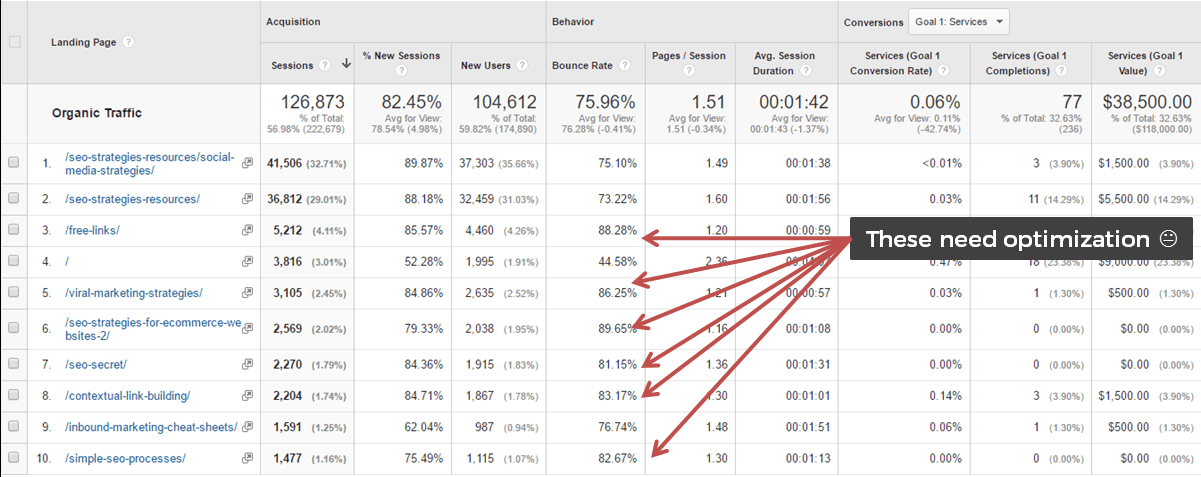
You can then identify which key terms are being used by searchers to get to these pages, via Google Search Console.
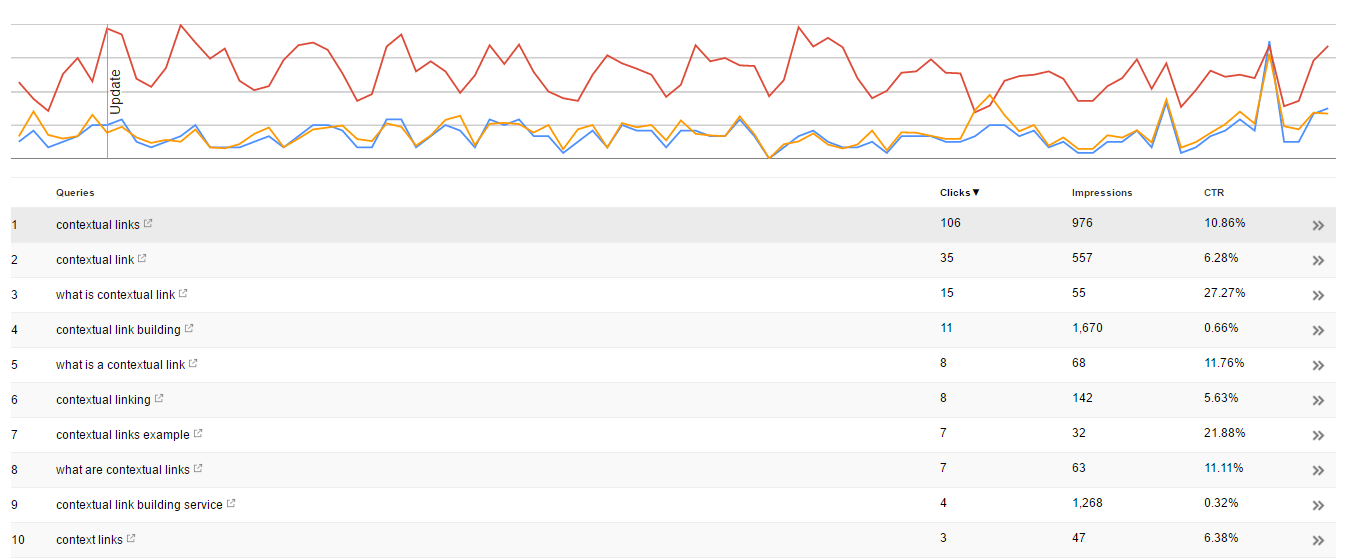
Match searchers’ intent by providing the answers and expected experience based on the queries being used by the majority of the page’s organic visitors – mainly by placing the answers where searchers can instantly see them (above the fold).
For further reading, I recently wrote a guide on how to optimize for user satisfaction that you can also check.

Jason Acidre
Focus on Keyword Research
Spend a large amount of time on keyword research. People have really discounted this part of the process lately, but it’s still the most important step in my opinion.
Your keywords set you up for either success or failure. Pick keywords that have low competition, high enough search volume, and the correct buyer intent behind them.
Really think about your customer and what they might be searching for. Not only the obvious keywords, but related keywords and pain points your customers might have.

Michael Karp
Get Links through Guest Blogging
Despite what you’ve probably read online, guest posting isn’t dead. Although some SEOs view this as a shady practice (after Google’s Penguin update), guest posts are still a great way to earn quality backlinks. The trick is that you always want to aim for quality and relevance.
If the links are from a spammy website, in the best-case scenario the link won’t provide any real value, and in the worst-case scenario you could get penalized by Google. In addition to the quality of the website, Google also looks for relevancy. For instance, if you’re a food blogger, a link from a DIY home decor site might not be a great fit.
Not only does relevancy increase the value of the link itself, but it also increases the likelihood of generating referrals – so it’s not only an SEO play but also a great way to get new customers.

Brandon Seymour
Discover Keywords You and Competitors are Ranking for With SEMRush
When conducting keyword research and selection, many limit their strategies to free methods, such as Google’s Keyword Planner, autocomplete and related searches. One great paid solution I always use to discover keyword insights is SEMRush’s Organic Research report, which helps you discover keyword opportunities. Here’s a simple way to use it:
See what keywords you are ranking on the 2nd and 3rd page of Google for but haven’t identified. You could benefit by improving these to the 1st page of Google search results. For example, by improving keywords related to cataract surgery, Doctor Jeffrey Horn may benefit by moving up 10 to 15 positions in Google.

See what keywords your top competitors are ranking best for, and that you’re not aware of. Begin targeting. Doctor Horn’s SEO team may identify and target variations of LASIK eye surgery keywords that his competitor Loden Vision Centers is ranking for, such as “conventional LASIK”.


Ben Wynkoop
Combine SEO with PR
My actionable SEO advice is to combine SEO with PR. I have learned in practice that merging SEO with PR in one campaign brings skyrocketing results. Recently, I’ve noticed that my personal blog’s content created with no focus on SEO has started to perform better and better with each passing day in Google search rankings:

Let’s take a look at my website backlink profile (see the figure below). As you can see, link juice to my website is increasing, since I receive backlinks from popular domains (Ahrefs Domain Rank has a significant positive correlation with Google’s search rankings).
Yet, I’ve started acquiring the right kind of links to my website not by doing link building per se, but by taking actions that boost awareness of my brand. I contribute to various blogs, deliver speeches and participating in webinars on a regular basis, and my website’s backlink profile has started growing as a result of these activities.

Therefore, by running a PR campaign I’m simultaneously investing in SEO. At the end of the day, I not only get publicity and a growing brand presence, but also my website starts ranking higher in Google and receives organic traffic. Unfortunately, a lot of businesses neglect the power of PR and focus solely on ranking high in Google’s results, hence it doesn’t come as a surprise that they’re producing low-quality content and getting tons of links from the websites that hardly referring any traffic.
I do understand that PR in majority of cases requires a lot of resources, ー since in order to produce and distribute an article one needs to have a good content marketer as well as an outreach specialist, ー but it’s definitely worth it.
The reason it’s so important to think of SEO in connection to PR is pretty simple: Google also pays attention on how well-known and trustable your brand is and ranks higher those websites that are able to gain these metrics. Thereby, I highly recommend to combine SEO with PR, because it proves to be one of the quickest ways to get a sufficient number of quality links and brand mentions and stand out in Google.

Alexandra Tachalova
Link building
High quality white hat links are the one metric that moves the needle every single time.
One of the easiest ways to discover link opportunities is to simply look at your competitors link profile, find someone linking to content similar to yours and ask them if they would link to you as well.Here is one of many ways to go about doing this…


This next step is very important…
Look for RELEVANT content (to what you’ve already produced) with large amounts of linking RD’s.
Here is the first email:
Hey hey FIRST NAME!I recently stumbled upon DOMAIN and really loved what I saw! (yes I actually read your stuff) :)I emailed you today because we created a guide that lines up with one of your posts on TOPIC. It’s called “5 Step SEO Strategy That Will Increase Your Rankings And Traffic”Thought you might be interested in it since you’ve written about TOPIC and it has some interesting angles that weren’t mentioned in some of your content.Let me know if you’re interested in seeing it and I’d be happy to forward it along.Either way, I hope the rest of your day is great, FIRST NAME! =)Be awesome!
Keith
•••••••••••••••Again…. customize this template and make it your own.
When / If they respond and say yes, send them this next email:
•••••••••••••••
Hey, [First Name]!
Thanks for getting back to me. I really appreciate it! =)
You can check it out here: [Your Post You Want Links To].
If you wanted to add it to your site, I’d be happy to write a fitting paragraph to insert it inside this post: [Their Content We Want A Link To]
Looking forward to your feedback, [Their Name]! 🙂
Be awesome!
Keith
•••••••••••••••
Do this, over and over and you will succeed and outrank your competitors. 🙂

Keith Bresee
Negotiate With Terrorists
You have a gun to your head; how do you maximize your chances of walking away alive?
Time.
“NO WAIT”, a cliche plea victims in movies utter when they are about to meet an untimely demise. They know instinctively to bide time, connect on a human level with the attacker, and increase life expectancy. Website visitors are empowered by choices, whether goods or services, all can be readily seen and analyzed online.
This empowerment, by consequence has created extremely informed, over-confident, entitled customers. They want to know your best price, and they want to know it now! Weaker brands fall victim, playing into the power struggle by supplying a knee-jerk reaction, price first mentality, versus a value add proposition. Of course, value can only be established through proper story-telling, only achieved with ample time.
In an ideal world online, all prices would be 100% transparent and customers would make buying decisions based on value, not simply price.
Unfortunately, this business utopia is usurped by subsistent reality, “I want to spend the least amount of money”. We all know a $1 hamburger can’t be as quality as a gourmet, $20 hamburger, yet this self-preservation mode, of not getting taken advantage of, exists in all of us as humans. Our job is to not judge or hate the customer for this approach, but to understand where they are coming from – no one wants to lose money or time. The best ways to transition from fear and price mentality is through a modality of trust: case studies, bios (headshots), media (videos). Can you do this for me? Have you done it for others, and do you truly want my business?
Humans connect with stories, this is why Marvel movies outperform nearly all competitors, through origin stories. The Punisher is one of my personal favorites.
A snapshot of the Punisher is a cold-blooded murderer, but if you look to his backstory you quickly empathize with his family being slaughtered at a reunion, and route for his revenge. After all, the batman would be no one without the Joker.
While 90% of the SEO battle is promotional, if you aren’t effectively telling your “why”, and how you helped others just like Joe Schmo or Sally Sue, the customer, through no fault of their own, only has price to base their buying decisions on, as you did not soft-sell them into seeing all the added value through your goods and services.
This is why personal consultations, live chat, real time communications are critical to speaking directly to the consumer, on a 1:1 basis, rather than relying on 1:many.
Mass marketing (1:many) case studies coupled with 1:1 time shows you are competent, able to service them, and want to service them (if you hate what you sell or do its readily apparent to the consumer). While adding video, calls to action and stories are perfect Onpage SEO, this can be taken to its logical conclusion Offpage (promotions) as well.
Even if you have case studies, everything is hosted on your own website. A singer who tells you they are great, usually falls on deaf ears, or skeptical, yet if other people tell you how great someone is, you are more likely to listen. This 3rd party, independent vote is the basis of Google and search engines.
By engaging on the blogosphere, directories, websites, social media and press contacts, you are effectively telling your story through a 3rd party medium, magnifying the story telling done through your own website.
The end result is a consistent brand message of excellence, focused on the user experience, and promoted both internally (on your own website) and externally (3rd party websites and social media). The combination of the two is true dominance as your user-centric approach and public relations SEO promotions, allow the search engines to rank you with confidence.

Matthew Anton
What are SEO techniques you use? Which ones do you think work best? Share with us in the comments below!

Comments (0)